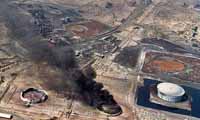Iraq Invades Iran
Iraq attacked Iran's airbases on September 22, 1981, then sent ground troops across the border, in a three-prong assault on Khuzestan, an oil-rich province in southwestern Iran. Saddam Hussein sought to take advantage of Iran's domestic turmoil in the wake of the 1979 revolution. He hoped for a quick victory and believed the attack might dislodge Iran's fundamentalist regime, which openly supported the overthrow of his Ba'ath government.
Khomeini holds much blame for provoking Iraq. After returning to Tehran in 1979 and taking credit for ousting the Shah, the Ayatollah declared his next target was Baghdad.1 The mullahs called for an Islamic revolution in Iraq and provided financial support to political groups in the country to achieve this end, violating terms of the 1975 Algiers Agreement. Five days before the invasion, Saddam abrogated the Agreement with Iran and demanded a return to the border demarcation prior to 1975.2
 Tehran mounted a fierce retaliation. Its air force attacked Iraqi airbases, oil refineries, petrochemical plants, dams, and other strategic targets. In Khuzestan, fighter jets and helicopter gunships pounded Iraq's armored divisions, slowing their advance.
Tehran mounted a fierce retaliation. Its air force attacked Iraqi airbases, oil refineries, petrochemical plants, dams, and other strategic targets. In Khuzestan, fighter jets and helicopter gunships pounded Iraq's armored divisions, slowing their advance.
"People's Mojahedin
The People's Mojahedin of Iran (PMOI) rallied to a call to arms, sending hundreds of fighters to the front to battle the Iraqi invaders. Mojahedin members and supporters "went to the front immediately," a U.S. State Department report said.3 "They were tolerated by the fundamentalists only in the first hectic days of the war, and most were soon expelled."4
The Mojahedin took the principled position that Iraq's action was an act of aggression, knowing full well the mullahs had antagonized Iraq by meddling in its internal affairs in an effort to overthrow the government and replace it with an Islamic republic.5
In the conflict, a large number of PMOI members and supporters were killed or taken prisoner by Iraqi troops.
Iraq Retreats
Four months after the war began, Iran initiated a series of successful counterattacks against Iraqi forces. By March, the fighting had come to a standstill. Thereafter, territory minimally changed hands until late 1981, when Iran mounted a large-scale assault that forced Iraq's troops to withdraw. As reported by the Associated Press, "The Iranians began to turn the tide of battle against Iraq in March 1982 and gradually forced the invaders to retreat across the border."6
The months of fighting took a heavy toll on Iraq's military capability. There were many casualties and its armored divisions and air force were severely weakened. Although Iraq maintained an advantage in some areas, such as tanks and helicopters, its overall military strength and supplies were insufficient to maintain control of Iranian territory.
International Opposition
Iran's battlefield successes and its announced intention to replace Saddam with a fundamentalist government were viewed with alarm by many countries. For the Persian Gulf states, the mullahs' regime was a threat to peace and security and they feared it would destabilize the region. In response, they offered financial support to Iraq to counter the advancement of the mullahs' regime.
1) "8-Year Gulf War: Victims but no Victors." New York Times. July 25, 1988.
2) "Non-Aligned Peace Commission Takes Message to Iraq." Associated Press. May 11, 1981.
3) "People's Mojahedin of Iran." U.S. Department of State. October 28, 1994.
4) Ibid.
5) "Enemies of the Ayatollahs." Mohammad Mohaddessin. Zed Books, London. New York. 2004.
6) "Iran's Army Remains Potent Despite Losses, Purges." Associated Press. July 19, 1982.

